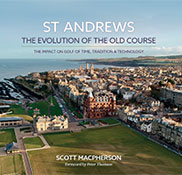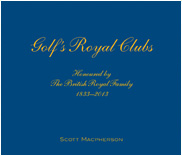GOLF CHAMPIONSHIPS ON SMGD COURSES:
At Close House – Colt Course. Sept 2017. A prestigious European Tour Championship hosted by Lee Westwood.
Broadcast worldwide from Royal Wellington Golf Club, NZ. October 2017. WOW!
The legacy continues.
Co-hosted at the award-winning Millbrook Resort near Queenstown, NZ. 2014 – 2023.
Forests or Fairways?
In 1928, famous golf course architect Charles Blair Macdonald said, “No course can be ideal which is laid out through trees“. As many modern courses are routed through forests or open woodlands, and most courses continue to plant trees, what is the ideal relationship between a golf course and trees?
Early British golfers seemed to object strongly to trees on a golf course, perhaps it was a by-product of their links upbringing. Willy Park Jr said in his book ‘The Game of Golf’ (1896), “Trees are never a fair hazard if at all near the line of play, as a well hit shot may be completely spoiled by catching the branches“. Garden G Smith sympathised writing in his famous book ‘The World of Golf’ (1898), “Now the tree is not, and never has been, in the written history of golf at any rate, a golfing hazard. Bunkers and their like have always been on the ground, and not suspended in mid air. Therefore, if you have trees on the ground, it will be wise to layout your course so that they never occur in a straight line of fire. If they do they should be cut down. It may spoil the landscape, but it will improve the golf – and the language”.
More recently, golfers and course designers have often taken a different view. Most believe trees can strategically and aesthetically enhance a course and provide significant on-course habitat. In 1927, William Flynn wrote in the USGA Green Section Bulletin that in the preliminary layout of a new course, “Sometimes a slight change in the alignment of the hole permits the architect to keep a specimen tree or trees which may also act as a key or turning point in the hole”. Of course, this also applies to tee positions and as Flynn concludes, “(this) generally improves the layout”. So what are the best places for trees on a golf course?
Dr MacKenzie had clear thoughts on the matter. In his ‘lost’ manuscript written in 1934 entitled ‘The Spirit of St Andrews’, MacKenzie wrote, “Trees should not usually be placed in a direct line with the hole, as they block the view too much. They make an excellent corner for a dog-leg”. His 17th hole at Cypress Point in California is a good example. However, he elaborates further, “Groups of trees are the most effective way of preventing players reaching the green with their second shots after playing drives in the wrong direction“. In his search for naturalism in his designs, he embraced things he saw occurring naturally in the wild; sweeping sand dunes, slow rolling fairways and groups of trees. “Playing down fairways bordered by straight lines of trees is not only inartistic but makes tedious and uninteresting golf.”
Apart from strengthening doglegs, trees can be exceptionally good at screening. Either for the purpose of hiding unsightly areas, providing a golfing buffer or protecting buildings and boundary’s, trees can blend beauty with protection. However to do so, the selection and arrangement of the trees must be done in the correctly. Allowance must be made for future growth and crucially, be done in groupings that appear natural.
As for tree selection, deciduous trees are usually an inappropriate choice. The cost of clearing leaves and the frustration to the golfer of searching for balls amongst fallen leaves are major drawbacks. Their only advantage is they let light hit the ground during the long winter months, a fact which is especially crucial if the trees are located near to a tee or green! However MacKenzie preferred evergreens. He said, “All evergreens are suitable for a golf course, while on the other hand, deciduous trees make a mess and look out of place”.
Deciduous or not, trees are best kept away from tees and greens according to Charles Blair Macdonald. He observed, “Trees foreshorten the perspective and the wind has not full play”. While Macdonald’s reference to the wind is related to the effect it has on the ball and a player’s depth perception, from an agronomic perspective, allowing the wind ‘full play’ can reduce incidences of turf diseases such as red thread, anthracnose and the two major diseases caused by excessive shade, Fusarium and the especially common leaf spot disease. Judiciously reducing tree numbers is the most cost effective solution and can eliminate additional problems such as blocked drains from tree roots.
Dr MacKenzie concluded, “Most of the best inland courses owe their popularity to the grouping of trees”. I agree. Will we ever forget Sergio Garcia’s famous escape shot from the roots of a tree against Tiger Woods in the US PGA at Medinah in 1999? So contrary to the thoughts of early architects, trees do indeed have a place on inland courses, but golf courses are not arboretums and tree selection and placement require expert consideration to improve the strategic challenge of a golf course for all players. If they have outgrown their purpose strategically or interfere with the course agronomically, remove them. Clubs should have a ‘Tree Plan’ and continually monitor the health, status and size of all trees. When the golf is compromised, the tree must go.
Trees can only enhance a good course and not make it good. I think it is important to balance the strategy of the design with your greenkeepers ability to provide healthy turf year round, and to use trees primarily to frame holes. Golf is no fun when the route to the green is more forest than fairway… even if your name is Sergio.
AWARDS
 Winner
Winner
Excellence in Compliance Award
Royal Wellington Golf Club
 Scott awarded by GEO as a Sustainable Golf Champion
Scott awarded by GEO as a Sustainable Golf Champion
PUBLICATIONS
 St Andrews
St Andrews
The Evolution of the Old Course
by Scott Macpherson
TESTIMONIALS
"When I was looking for a golf architect I wanted someone who would understand the landscape and have the flair to design a course of the highest quality in terms of; aesthetics, a player's and playing perspective; being practical in terms of forward maintenance; and to bring the construction in on time and on budget. Scott is that man! And what's more he brings competence and professionalism and an easy management style and enthusiasm that is infectious and at no extra charge – a little bit of magic to it all!"
Derek Young, Chairman Kersewell Resort Group, Scotland, UK.



